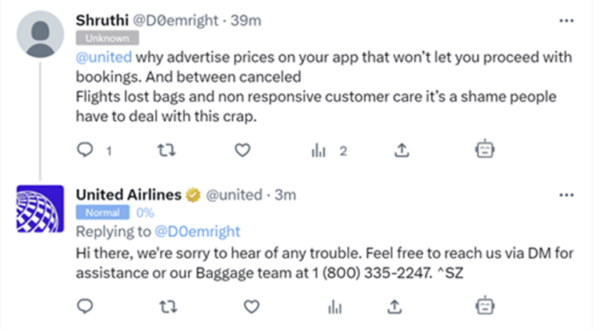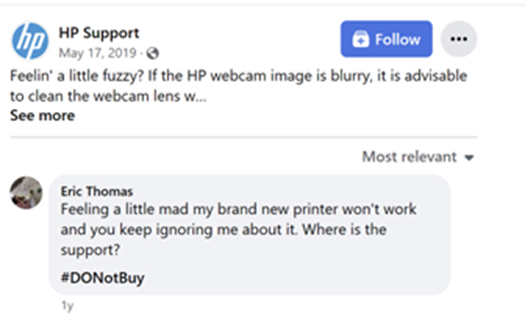MARKETING
Have a Feedback Strategy? You Better Because Your Audience Is Watching

Engagement metrics don’t tell the whole story.
A lot of B2B and B2C marketers – more than 75% – use engagement with email and websites to evaluate content’s impact. About three in four assess social analytics and their engagement metrics.
While engagement numbers work well as a measurement of interactivity, they don’t work as well to understand the person’s sentiment. That requires a qualitative assessment, and, more importantly, it often requires a qualitative response in real-time.
When audiences engage with your content and brand, your engagement with those reactions – their positive and negative feedback – can make a difference in how those people feel and think about your brand. And, when the feedback comes in a public forum, your response can make a difference in how digital bystanders view your brand.
Your brand’s response to feedback can make a difference in how critics and digital bystanders view your company, says @AnnGynn via @CMIContent. #SocialMedia Click To Tweet
That’s why you need a strategic feedback engagement system that all content marketing team members know and implement. Here are some ideas to help you create a successful plan:
View comments as invitations
Everybody wants to be heard. That’s why it’s so important to reply to comments on your social media or email messages to your company. You’re acknowledging that you saw and heard the message (and, ideally, the sentiment behind it).
Honeylove, a shapewear clothing brand, replies thoughtfully to every comment – positive, negative, or neutral – on its Facebook page. In this post, it tackles all three:
- After one person commented, “Love mine!!” The brand replied: “Thank you so much for taking the time to share your experience Irene Armstrong Field! We are absolutely thrilled that you love our garments as much as we do If there is anything you’d like to see from us in the future, let us know! We would love to hear from you ”
- When another person tagged a friend, the brand thanked them for sharing it.
- Someone else commented: “None of the women I’ve seen even have a weight problem.” That prickly statement might challenge some, but Honeylove was ready. They thanked her for the feedback and responded to correct her perceived criticism gently. They explained their size range (XS to 3X/4X). And said, “We have many posts with a diverse range of body types, all of whom look amazing in their Honeylove,” before sharing links to two videos that back up the statement. (The commenter thanked them for the thoughtful reply.)

All that interaction by the brand with the people who engaged with the brand’s Facebook content communicates to their audience that they value the interactions and are keenly interested in what their audience has to say. Taking the time to do that can have a bigger impact than just clicking “like” to indicate you read their post or, worse, doing nothing when people engage with the brand.
Taking the time to reply with more than a “like” lets your response have a bigger impact on the commenter and others, says @AnnGynn via @CMIContent. #SocialMedia Click To Tweet
TIP: Honeylove uses the commenter’s name in their reply. That personalization indicates to the commenter and other viewers that it’s not a formulaic, cut-and-paste response.
Listen, consider, research, act (or don’t)
Earlier this year, someone replied to CMI’s Monday newsletter from Kim Moutsos with a critique of her greeting: “Hi there.” To them, it sounded impersonal and snooty.
Now that’s an engagement victory – a real-life reply – even if the feedback wasn’t so positive. The subscriber mentioned they shared the opinion because Kim invites readers to share their feedback in every newsletter.
But now the question arose, what should she do with that feedback?
Kim replied to the critic. But she didn’t stop there. She started an internal conversation about the greeting’s appropriateness and possible alternatives. In her next weekly email, Kim shared the reader’s thoughts on the greeting and asked for more input. Others responded. Multiple conversations between CMI and individual readers – including the original commenter – ensued.
After all that, Kim still uses the greeting, “Hi there,” but she does so after taking the initial feedback seriously and learning upon further investigation that the constructive comment didn’t resonate with others.
Sometimes, feedback leads to a change. For example, a reader commented on the CMI blog that they found it hard to read because the related content boxes throughout the article disrupted the experience. After further consideration, CMI condensed the related content boxes into a single box and moved it to the end of each article.
Sabina Muminovic, content marketing manager at GenePlanet, guides their responses to feedback, particularly for reviews of their company on Trustpilot.
She maintains a list of relevant feedback and routinely reviews them with the product team to discuss solutions. “Why not use every opportunity to improve,” Sabina says. “Often, our customers see the forest we missed by looking too closely at the trees.”
Why not use feedback as an opportunity to improve? Often customers see the forest we missed by looking too closely at the trees, says Sabina Muminovic via @AnnGynn @CMIContent. #SocialMedia Click To Tweet
While GenePlanet takes a case-by-case approach to feedback now, it’s using that to distill the framework for a future company-wide policy.
Acknowledge the critics and haters
Of course, some members of the public can be mean and vicious in their feedback. They often don’t even use their names, hiding behind gobbledygook handles and email addresses.
In these cases, you can take two courses of action – reply to them or don’t. In most cases, I favor the reply, particularly if they gave the feedback in a public forum. Simple phrasing such as “Thank you for your comment” or “We have read your comment” should suffice. The reply doesn’t debate or challenge them. That just stirs the pot and gives them what they want – a reaction to which they can respond with more of what they said originally.
Of course, if they present factually incorrect information, your reply should include a credible source with the correct information: “Thank you for your comment. The (fact) is correct as shown in (add a link to a credible source).” After you post that, don’t respond to any subsequent conversation from the original poster, as it indicates to the audience that person deserves even more of your time.
Sabina says when a critic doesn’t accurately reflect their product or service because, for example, a user error was made, GenePlanet responds respectfully but clearly correcting the misperception.
“I believe such an approach strengthens the brand’s credibility and trustworthiness. It takes more time and requires really good copywriting, but it pays off,” Sabina says.
Now, some organizations might be regularly involved in subject matter that elicits frequent outcries from the public. If that’s your group, consider implementing a standard acknowledgment for all feedback – positive or negative, such as: “Thank you for sharing your thoughts with us.”
Move the conversation
Feedback on social media plays differently than it does in a direct email. Your audience can see the dialogue in real-time. When you find yourself replying back and forth with an individual on your social channels, consider what the airlines and other brands do on Twitter: Change the forum.
In this tweet, a customer tags United Airlines and complains about its advertised pricing promises, lost luggage, and non-responsive customer service, concluding, “It’s a shame people have to deal with this crap.” United responded with an apology and a request to contact them via direct message or by the phone number provided.

You end the public debate by inviting the critic to contact you directly. Even if the commenter never reaches out directly, your audience knows you tried.
HP Support made that mistake on Facebook when it left a negative comment sitting there for three years and counting without a supportive reply.

The post topic (how to fix a fuzzy HP webcam) isn’t what the commenter talked about (a new printer that won’t work and HP’s ignoring his support inquiries. However, it presented the perfect opportunity for HP Support to live up to its name, reply, and move to a one-on-one conversation. While Eric Thomas (the commenter) may never have been satisfied, I wouldn’t have seen HP’s lack of support confirmed three years later after a Google search delivered this content to help solve a problem with my webcam.
Make a feedback-response plan
Too often, brands and their digital teams make their replies to feedback on a case-by-case basis. But that can get you into trouble. Some team members may reply to all, and some may reply only to those asking questions. Audience members who do not get a response will feel slighted because others did get the courtesy of an acknowledgment from the brand.
To avoid all that, write a reply strategy. Detail when and how the team should respond to someone. For example, does it merit a simple acknowledgment, or should it start a conversation? You likely don’t have a one-reply-fits-all situation, so come up with a standard list of replies to the most frequently shared feedback. Next, set up a process so your team knows how to share the feedback with the departments to which it is relevant. Finally, establish guidelines for when the feedback recipient should escalate the internal conversation before they respond. Send a draft of the feedback-response plan to all the stakeholders for their input before you finalize the strategy.
By developing a deliberate feedback engagement strategy, your brand will benefit from both positive and negative engagement – and your audience will too.
HANDPICKED RELATED CONTENT:
Cover image by Joseph Kalinowski/Content Marketing Institute


















